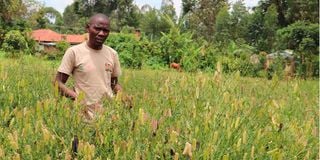Seed bank saves dozens of long-lost indigenous vegetables from extinction

Evans Ochuto at the traditional vegetable and seed bank farm in Vihiga County.
Dressed in a brown trouser and a marching T-shirt, Evans Ochuto picks a green pod from one of the plants on a farm in Vihiga County he is inspecting and opens it.
He grimaces, before picking another pod – brown in colour – and then smiles as he blurts out, “we will harvest them soon”.
Ochuto is talking about the seeds of the various traditional vegetables that they grow. He is the manager of a seed bank run by 10 community-based groups in the county. The organisations grow the indigenous vegetables, harvest the seeds, store and sell them to seed companies and farmers in a venture that is bringing back to life some crops that were on the verge of extinction.
“When you talk about indigenous vegetables, what many people know is terere/dodo/mchicha (amaranthus), managu/lisutsa/osuga (black nightshade), kunde (cow peas) and mrenda (jute mallow). However, there are many others that were there in past, but modernity almost pushed them to extinction yet they are not only nutritious but are also climate-resistant,” he says.
In their seed bank, Ochuto says they have seeds of resilient vegetables that include Vigna membranacea (shikhubayeka), Commelina spp.(linyolonyolo), Erythrococca bogensis (esirietselo), esinatipa and lirunde.
“Some of these vegetables we don’t have their Swahili or scientific names because they were forgotten,” says Ochuto.
Resistant to dry spells
In days of yore, vegetables came in handy, especially during times of drought, because they are resistant to dry spells.
Abraham Okatsio, 74, recalls some of the worst droughts in the late 60s and mid-70s when esirietselo, indelema (vine spinach) and esinatipa were the only surviving edible leafy vegetables.
“The last time I ate esinatipa is in 1980, during a hunger that was known in this region as gorogoro. By then, esirietselo was almost extinct because it is a shrubby plant that wildly grew in bushes, but then, people have cleared those bushes to open space for farming, settlement and development,” says Okatsio.
Ochuto notes they started the venture dubbed Vihiga Nutrition and Community Seed Bank eight years ago with an aim of reviving indigenous leafy vegetables, herbs and other crops that were used as alternative diets during extreme droughts, and for medicinal and cultural purposes.
“In the bank, we have 80 varieties of the various indigenous vegetables and herbs, including Ajuga integrifolia (imbusi yu mutakha), which was normally mixed with other herbs like Senna occidentalis for treatment of stomach ailments and malaria, among other diseases.”

Evans Ochuto with produce from the Vihiga Nutrition and Community Seed bank. Photos | Isaiah Esipisu
For quality seeds, they are careful from where they source the seeds.
“When we started in 2014, we tried buying some of the planting materials from the open-air market, and one day, I ended up buying Sesbania sesban, disguised as spider plant seeds,” he offers.
They now source them mostly from elderly women who have been preserving them for years.
“These women have a lot of indigenous knowledge on African leafy vegetables, that’s why we have recruited 30 of them as our custodian farmers who help us with seed multiplication,” says Ochuto.
Once they get the seeds they want, they collect them and share them among members for multiplication.
They get more seeds from the National Gene Bank in Nairobi, or from farmers in Uganda for multiplication.
Through this process, the group has been able to resuscitate 15 traditional varieties of sorghum, five varieties of millet and over 50 varieties of beans.
For the vegetables, they have recovered Commelina spp (linyolonyolo), bitter flavoured mitoo (Crotalaria), different varieties of the spider plant (sagaa), three different varieties of the vine spinach and African amaranth.
The biggest volume the 300 farmers have been able to produce under a contractual arrangement with a processing company is 6.2 tonnes of amaranth seeds.
“We can’t claim that we are commercial seed producers because we are not licensed, therefore, we can’t package and sell seeds. What we are doing is simply preserving our indigenous vegetables, and when our members produce the planting materials, they sell to farmers,” says Ochuto, adding the members are not sold the seeds but given for free, which they must return double the portion upon harvesting.
Every member contributes Sh500 every month for the maintenance of the bank.
Prices
A tablespoon of spiderplant seeds goes for Sh30 while a kilo costs Sh2,000. For the golden brown Amaranth variety, which is used for food fortification, it goes for Sh1,500 per kilo. However, the African amaranth (libokoi) is the most expensive trading at Sh4,000 a kilo while jute mallow Sh1,200.
By attending different seminars and learning from field visits, the farmers have learned ways of ensuring that they produce good quality vegetable planting materials.
“During multiplication, we do proper thinning from one to three weeks after planting so that we remain with crops that are healthy. Then as they grow, we track every crop so that we select and retain those that grow well,” says Ochuto, adding that they know those that remain vibrant during severe heat give better seeds.
They also monitor those that resist common diseases and pest attack while in the seedbed, and upon maturity, such seeds are kept separately for further trials just to see if those traits are consistent
“When growing seeds, the first rule is that one should not harvest the vegetables from the plants. With that, you can be guaranteed up to Sh320,000 from a single harvest of spider plant seeds on an acre,” says Joseck Mukuna, one of the farmers.
Silas Too, an agronomist at Nandi County government, says the disappearance of many African leafy vegetables was not due to tough climatic conditions since many are resilient.
“Our farmers were simply attracted to commercial vegetables like cabbages and sukuma wiki. People started planting them in volumes pushing consumers away from traditional vegetables. Reviving them is, therefore, timely as climate change effects bite.”
Vihiga governor Wilbur Ottichilo notes that the county government supports the growth of the African leafy vegetables, in collaboration with the Ministry of Sports, Culture and Heritage, as a way of preserving traditional knowledge on food and boosting incomes.
“The people of Vihiga are known to have diverse knowledge of various varieties of indigenous leafy vegetables. This is the knowledge we want to share with the rest of the country and beyond especially as climate change effects bite.”





